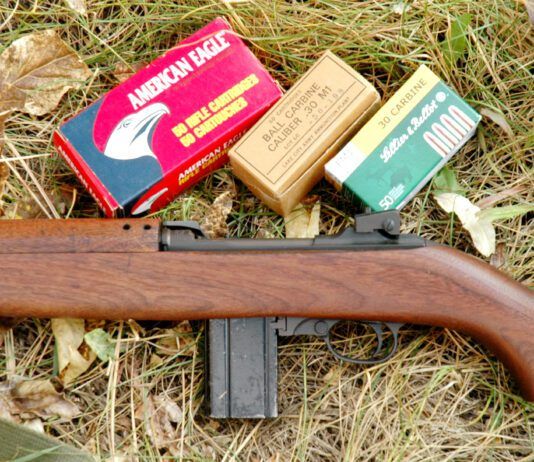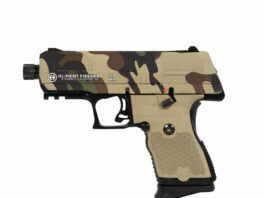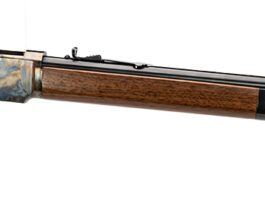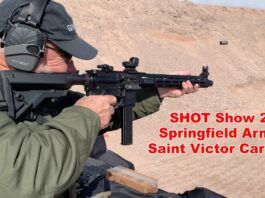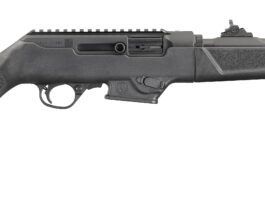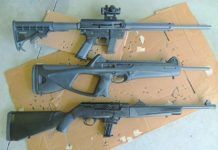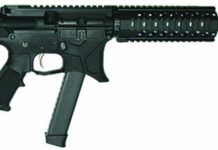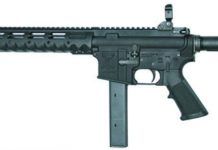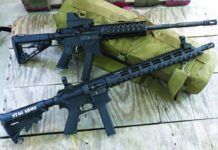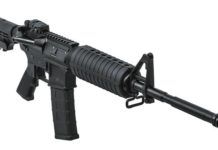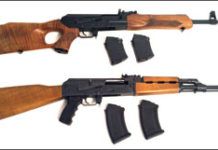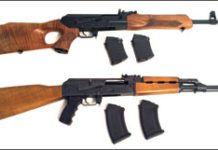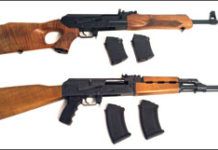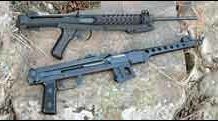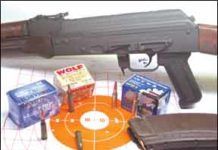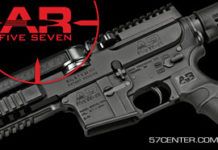9mm Rifles from Beretta, Just Right Carbines, and Ruger
Manufacturers have easily transformed the AR-15 platform to be compatible with 9mm ammo, and we have tested a few of these carbines back in 2015. Since then, there has been an uptick in new 9mm carbine models, so we decided to take a look at these short semi-autos that share ammo with your pistol. What separates these newer 9mm carbines from some AR-15 carbines is their ability to use handgun magazines. Not only do these carbines share the same ammunition, they also share the same magazine in your pistol. That's versatility in our book.
The three rifles we procured were the Beretta CX4 Storm, Just Right Carbines' Takedown Model, and Ruger's PC Carbine. These carbines offer mild recoil, good accuracy, fast follow-up shots, light weight, and maneuverability. Some, like the Ruger, offer all the bells and whistles and propel the 9mm carbine category from a pipsqueak pistol-caliber carbine to a versatile home defense and survival tool. In the past five or six years, 9mm ammunition has also evolved, and there are a slew of viable loads that make these carbines more versatile than 9mm carbines years ago.
Less recoil means better accuracy and faster follow-up shots, and we all know bullet placement is very important in disabling a bad actor. We'll take making the first well-placed shot any day. In our opinion, any of these carbines would made a good choice for home defense, for transport in a vehicle, as survival/prepper choice, small game hunting, and an all-round fun plinker. These also make a great transitional gun for shooters graduating from a rimfire round to a centerfire round. All of these carbines also offered an adjustable length of pull so smaller-stature shooters are not at a disadvantage.
All three of these carbines feed from handgun magazines and use a simple blowback mechanism. You can feel the bolt sliding back and forth in the receiver as the carbine cycles and that adds to the perceived recoil. These carbines are also light and perceived recoil is always higher in a lightweight rifle. In our opinion, the Beretta does the best job of making the mechanism feel smooth, and that's because the CX4 is more like and oversized pistol than it is a carbine chambered in a pistol caliber. The Ruger and JRC have added flexibility since they are takedown models. Plus the Ruger does a whole lot more. The Ruger PC Carbine is packed with features that actually make the carbine more flexible, adaptable, and useful. Some of our more jaded testers kept going back to the PC Carbine for another try, which says a lot.
Rifle Stats: Tresna Defense JAG9G BU 9mm Luger, $1,100
This is a quality rifle with good accuracy and the added benefit of being compatible with Glock 9mm magazines of any size.
Rifle Stats: Stag Arms Model 9T 9mm Luger, $1,275
A well-made and well-equipped rifle out of the box. The 9T offered a slightly better trigger pull and slimmer,more-user-friendly handguard.
Pistol-Caliber ARs: We Pit the Stag Arms 9T, Tresna Defense
Carbines chambered in 9mm with AR-15 controls have been around since the 1980s, when Colt developed the Colt SMG, a select-fire carbine. Since military and LE agencies were familiar with the AR platform, it made sense to create a rifle that offered less penetration, less perceived recoil, less muzzle blast, and better short-range control.
Today's advances in ammunition technology has nearly made the overpenetration problem moot. Load an AR chambered in 5.56x45mm NATO with the right bullets and you can control overpenetration, and, of course, the same can also be said with newer 9mm ammo. However, if you're trying to decide on whether to add a 5.56 carbine or a 9mm carbine to your home-defense plans, the muzzle blast from the 5.56x45mm NATO causes some shooters to flinch. The 9mm produces nowhere near the muzzle blast. You pay a penalty for that ballistically, because there is a chasm between the 9mm pistol round and the 5.56 rifle round, which is why the Colt SMG was and is primarily used as an entry weapon to provide a high volume of firepower that can be effectively controlled. If you can't decide, there are plenty of kits that allow a user to adapt a 5.56 AR lower and put on a 9mm upper receiver and a drop-in magazine block to make the 5.56 magwell compatible with 9mm magazines.
What a 9mm AR really offers is a long gun and handgun that share the same ammo. That concept has been around since the days of the Old West because it made sense then and it makes sense today. Another factor to consider is ammunition cost; 9mm ammo, in some cases, is nearly half the cost of 5.56 ammo, and a fairly good assortment of 9mm can usually and easily be found in big-box stores as well as your local mom-and-pop gun store. These rifles also offer nearly the same amount of customization as a standard AR-15 carbine — pistol grips, handguards, BUIS, optics, charging handles, safety selectors, triggers, muzzle devices — allowing nearly an unlimited amount of personalization.
We recently tested two 9mm ARs that look like and have the same controls as an AR-15, but their operating systems were quite different. The Stag Arms 9T and the Tresna Defense JAG9G BU use simple blowback mechanisms, not a gas-impingement system or a gas piston system like on an AR-15/M16 rifle or carbine. In a blowback action, there is no gas block, gas tube, or a piston, and the bolt-carrier group is noticeably different. The AR's bolt-carrier key is not needed, and the bolt carrier is heavier on a 9mm AR compared to a traditional AR-15 bolt carrier. Because the blowback system works off the resistance of the bolt and recoil/buffer spring, a heavier bolt carrier is required. You can feel the effect when the rifle cycles. The bolt and recoil spring move rearward from the force of a shot fired to eject the empty case and cock the hammer. They then move forward via the recoil spring in the buffer tube, with the bolt pushing a cartridge out of the magazine and ramming it into the chamber.
Since 2003, Stag Arms, located in Connecticut, has been manufacturing Mil-Spec AR-15 rifles in a variety of furniture and caliber options; in addition to 9mm, the company offers 5.56mm, 300 BLK, 6.8 SPC, and 22 LR. Stag also makes left-hand variants with the ejection port located on the left side of the rifle. Stag Arms manufactures 80 percent of its parts in house, with only the plastic pieces and some of the small springs manufactured by other vendors. Tresna Defense introduced its civilian rifles in 2014. Located in Georgia, Tresna (which means tool in Basque) makes models compatible with 9mm or 40 S&W magazines from either Glock or S&W M&P pistols. So, depending on your handgun brand and caliber preference, you can have a Tresna rifle that uses the same magazine.
Both of these ARs are dedicated 9mm platforms, meaning they are built specifically to fire 9mm ammo with a dedicated 9mm upper and lower. There are other similarities. Both featured a 16-inch barrel with an A2-style flash hider, A2-style pistol grip, single-stage trigger, and each came in a hard case with one magazine. From there, the rifles' features diverge. The biggest difference between these two rifles is the Stag Arms uses a Colt-style stick magazine, while the Tresna Defense uses Glock Gen4 9mm magazines. We found that the ability to use the same magazines in our handguns and rifles offered a lot of flexibility. Another difference is the Stag Arms 9T is ready to be used out of the box, due to the flip-up sights being included. The Tresna Defense JAG9G BU does not come with sights, so that can become another way for consumers to separate these two highly-ranked products.
AR-15 Models Head to Head: CMMG and Battle Rifle Co.
It isn't unusual for a dozen AR-15 rifles from different makers to be on the shelf at most gun shops. Some are regional makers, some are giants like Colt, and a few are new companies trying to earn a good name for themselves. The modular construction of the AR-15 means that the basic receiver may be fitted with a number of different barrel types, stock designs, and other accessories. As such, the price point is flexible, depending upon whether the user wants an entry-level rifle or something more. We picked the rifles in this report to see if the details and accessory package on a more expensive rifle really offered enough performance to justify the extra money. There are literally dozens of choices to make between rifles in this price zone, so as much as anything, this was a test of accessories and set-up, culminating in our advice on how to buy an AR that's a flexible platform for growth as possible.
Lo-Cap AK-47s: We Compare K-VAR VEPR, CIA N-PAP Rifles
Lo-Cap AK-47s: We Compare K-VAR VEPR, CIA N-PAP Rifles
Lo-Cap AK-47s: We Compare K-VAR VEPR, CIA N-PAP Rifles
Two Pieces of Firearms History: Sterling, Pioneer Arms Compete
We acquired two historical and technically interesting firearms for this test. The guns were the 9mm Wise Lite Arms Sterling L2A3 9mm, about $500, and the Inter Ordnance/Pioneer Arms PPS-43C Pistol chambered in 7.62x25 Tokarev, also in the $500 range. The latter is officially a pistol because its folding stock is welded in the folded position. We found the folding stocks do nothing for their handling or practical function, but in close quarters that might be a handy feature. Both designs originally fired from an open bolt, and the Sterling was originally selective fire. These two test guns are both manufactured to fire semiauto-only, and they both fire from a closed bolt. We managed to find three types of 9mm ammo and two brands of 7.62x25 Tokarev, enough to wring out both guns. Here's what we found.
9mm Carbine Matchup: Kel-Tec, Thureon, MechTech, & Norinco
When it comes to personal defense, competition, and recreational shooting, the most popular rifle in America is likely the AR-15 chambered for .223 Remington. But there are still plenty of shooters who prefer the light recoil and low expense of 9mm Luger ammunition. Whereas caliber .223 is strictly the staple of rifle shooters, 9mm carbines are often used by pistol shooters who sometimes use a long gun. There are three basic types of 9mm carbine. They are the 9mm AR-15, semi-automatic versions of submachineguns such as the UZI, and purpose-built 9mm carbines that more or less follow their own rules of design. In this test we'll fire the $409 Kel-Tec Sub 2000 9mm, the $700 Thureon Defense 9mm, and Norinco's $800 UZI 9mm carbines. In addition we will also evaluate a 9mm conversion unit, the $505 MechTech Systems Carbine Conversion Unit for Glock. Our goal was to evaluate each carbine on its own merits and then compare the three types of design for personal defense.
Our choice of test ammunition was Winchester USA 115-grain FMJ rounds and two loads from Black Hills Ammunition topped with 124-grain bullets. One featured a full-metal-jacketed slug and the other a jacketed hollowpoint driven by a +P charge. Each carbine was tested for accuracy from the 50-yard bench using only their supplied open sights.


























